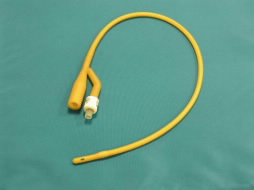EMBARGOED FOR RELEASE | August 22, 2012
“Smart catheters” for the major problem of catheter-related infections
Note to journalists: Please report that this research was presented at a meeting of the American Chemical Society.
PHILADELPHIA, Aug. 23, 2012 — A new “smart catheter” that senses the start of an infection, and automatically releases an anti-bacterial substance, is being developed to combat the problem of catheter-related blood and urinary tract infections, scientists reported here today at the 244th National Meeting & Exposition of the American Chemical Society.
The meeting of the world’s largest scientific society, which continues here through Thursday, includes almost 8,600 reports on new discoveries in science and other topics. Almost 14,000 scientists and others are expected for the sessions, in the Pennsylvania Convention Center and downtown hotels.
Media Contact
During Aug. 17-23, the contacts can be reached at 215-418-2086.
Michael Bernstein
202-872-6042
m_bernstein@acs.org
Michael Woods
202-872-6293
m_woods@acs.org
Dipankar Koley, Ph.D., who delivered the report, said the “smart catheter” technology is being developed for both catheters inserted into blood vessels and the urinary tract.
“About 1.5 million healthcare-associated infections are reported in the United States alone each year, resulting in 99,000 deaths and up to $45 billion in extra health care costs,” said Koley.
“Urinary tract infections, as one example, are the most common source of institutionally acquired infections in both acute care hospitals and long-term care facilities,” said Koley, whose report focused on early developmental work on the technology. “Our smart catheter is being developed in response to that need.”
Koley, a postdoctoral researcher in the lab of Mark Meyerhoff, Ph.D., at the University of Michigan, said the research team (including Chuanwu Xi, Ph.D., and Jianfeng Wu, Ph.D., in the School of Public Health at U of M) calls the new device an “electromodulated smart catheter.” He explained that bacterial infections can start on the surface of catheters, soft, flexible tubes inserted into blood vessels to deliver medication and for other purposes, and into the urinary tract of patients to drain urine. Some of the 30 million urinary catheters inserted each year, for instance, remain in place briefly, such as during surgical procedures. Other patients require long-term catheterization, such as patients undergoing kidney dialysis, and people in intensive care units and long-term care facilities. Many already are in frail health or are critically ill. Thus, major efforts are underway in health care settings to prevent catheter-related infections.
Infection-fighting catheters already are available, and work by releasing antibiotic substances, Koley said. These are “unintelligent catheters,” however, releasing the substances continuously, and thus soon become depleted and lose their antibiotic effect. The new smart catheter senses the start of an infection, and only then releases its antibiotic substance, which is nitric oxide (NO). In lab experiments lasting 7 days, test catheters have continued to release NO, and Koley and colleagues believe that can be extended to weeks.
The smart catheter works by chemically sensing changes in the pH, or acid-base environment, around the catheter. Certain changes signal the critical point when bacteria have formed a sticky film on the catheter, and their numbers have increased to the point where a health-jeopardizing infection begins. At that point, the catheter “turns on” and releases NO, which disrupts the bacterial films and stops an infection. It then switches “off”, preserving its reserves of NO-generating material.
To automatically receive news releases from the American Chemical Society contact newsroom@acs.org.
###
problem of catheter-related infections.


